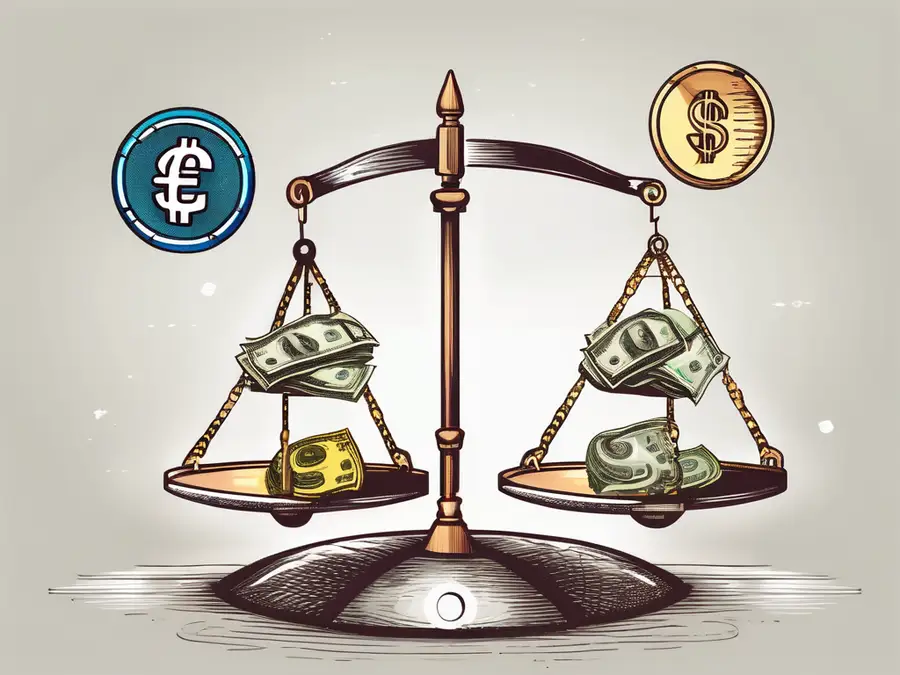Article Contents
The Carry Trade Strategy

As an expert in the field of finance, I am here to provide you with a comprehensive summary of the carry trade strategy. Whether you are a seasoned investor or just starting out, understanding the ins and outs of this strategy can help you make informed decisions and maximize your profits.
Understanding the Basics of Carry Trade Strategy
Before we dive into the intricacies of the carry trade strategy, let's first define it and explore its key concepts. The carry trade strategy involves borrowing money in a low-interest rate currency and investing it in a high-interest rate currency. The goal is to profit from the interest rate differential between the two currencies.
One of the fundamental factors that drive the carry trade strategy is interest rates. Central banks around the world adjust interest rates to manage their economy. When interest rates are low in a certain country, investors tend to borrow money at these low rates and invest it in currencies with higher interest rates, aiming to earn the interest rate differential.
The carry trade strategy has gained popularity among investors due to its potential for high returns. However, it is not without risks. One of the main risks is exchange rate fluctuations. When investors borrow money in one currency and invest it in another, they are exposed to changes in the exchange rate between the two currencies. If the value of the high-interest rate currency depreciates against the low-interest rate currency, the investor could face losses.
Another risk associated with the carry trade strategy is interest rate differentials narrowing or disappearing altogether. Interest rates are influenced by various factors such as economic conditions, inflation, and monetary policy decisions. If the interest rate differential between the two currencies decreases, the potential profit from the carry trade strategy diminishes.
Furthermore, carry trades are often subject to market sentiment and risk appetite. During periods of economic uncertainty or financial market volatility, investors may become more risk-averse and shy away from carry trades. This can impact the availability of funding for carry trades and potentially reduce their profitability.
It is important for investors to carefully assess the risks involved in carry trades and implement risk management strategies. This may include diversifying investments across different currencies, monitoring economic indicators and central bank policies, and setting stop-loss orders to limit potential losses.
In conclusion, the carry trade strategy involves borrowing money in a low-interest rate currency and investing it in a high-interest rate currency to profit from the interest rate differential. While it can offer potential high returns, it is not without risks. Exchange rate fluctuations, narrowing interest rate differentials, and market sentiment can impact the profitability of carry trades. Investors should carefully evaluate these risks and implement appropriate risk management measures.
The Mechanics of Carry Trade Strategy
Implementing the carry trade strategy involves a series of steps. Firstly, you identify a low-interest rate currency and borrow funds in that currency. This could be a currency from a country with a struggling economy or a currency with a central bank that has implemented a loose monetary policy.
Once you have identified the low-interest rate currency, the next step is to convert the borrowed funds into a high-interest rate currency. This is done by exchanging the borrowed funds for the desired currency in the foreign exchange market. It is important to carefully consider the exchange rate and any associated fees or charges.
With the borrowed funds now in the high-interest rate currency, the next step is to invest the money in assets or financial instruments that yield a higher return. This could include purchasing government bonds, corporate bonds, or even investing in stocks or real estate in the country with the high-interest rate currency.
As the carry trade strategy relies on interest rate differentials, it is crucial to monitor the interest rates of both the low-interest rate currency and the high-interest rate currency. Changes in interest rates can significantly impact the profitability of the carry trade. Traders often use economic indicators, central bank announcements, and market analysis to stay informed about potential interest rate changes.
Additionally, exchange rate fluctuations can also impact the profitability of the carry trade. Currencies are constantly fluctuating in value relative to each other, and these fluctuations can either work in favor of or against the carry trade. Traders need to closely monitor exchange rates and have a plan in place to mitigate any potential losses caused by adverse currency movements.
Finally, it is important to regularly review and assess the carry trade position. Monitoring interest rate differentials, exchange rates, and any relevant economic or geopolitical factors can help determine when it is time to unwind the trade and take profits. This requires careful analysis and decision-making to ensure that the trade is closed at the optimal time.
Like any investment strategy, the carry trade comes with its own set of risks. Exchange rate fluctuations can eat into your profits, and unexpected changes in interest rates can lead to losses. However, when implemented carefully and with proper risk management, the carry trade can offer significant rewards. Traders who are well-informed, disciplined, and proactive in their approach to managing the carry trade can potentially benefit from the interest rate differentials and generate consistent returns.
Evaluating the Profitability of Carry Trade Strategy
When assessing the profitability of the carry trade strategy, it's essential to consider various factors. The interest rate differentials between the two currencies play a crucial role. A wider interest rate spread indicates a higher potential return. Additionally, economic indicators, such as inflation and economic growth, can also influence profitability.
Measuring the success of the carry trade strategy requires careful analysis of your returns. Examining the overall return on investment, risk-adjusted returns, and comparing them to alternative investment options can provide a clearer picture of your performance.
The Impact of Global Economic Conditions on Carry Trade
Global economic conditions, particularly exchange rates and economic policies, can have a significant impact on the carry trade strategy. Exchange rates can fluctuate due to factors such as political events, economic indicators, and market sentiment. This volatility can affect the profitability of the carry trade and introduce additional risks.
Economic policies, such as changes in interest rates and monetary policies, can also influence the carry trade strategy. Central bank decisions and government interventions can impact interest rate differentials and exchange rates, potentially altering the attractiveness of certain currency pairs for carry trade opportunities.
Advanced Carry Trade Strategies
Diversification is an essential component of an advanced carry trade strategy. By spreading your investments across various currency pairs and asset classes, you can mitigate the risks associated with individual currencies or market movements. Diversification helps to reduce the potential impact of unexpected events and enhances the overall stability of your carry trade portfolio.
Hedging strategies can also be employed to manage risks in the carry trade strategy. Hedging involves taking positions or using derivative instruments to offset potential losses in case exchange rates move unfavorably. Various hedging techniques, such as forward contracts or options, can be utilized to protect against adverse currency movements.
Personal Advice and Expert Story
As someone who has been trading and researching the carry trade strategy for several years, I have personally witnessed both the rewards and the challenges it presents. One key piece of advice I can offer is to stay informed and keep a close eye on global economic developments. By staying up-to-date with interest rate changes, economic policies, and market sentiment, you can position yourself to take advantage of favorable carry trade opportunities.
I vividly remember a time when I was closely monitoring the interest rate differentials between two currency pairs. Based on my analysis, I identified an excellent carry trade opportunity and went ahead with the trade. Over the course of several months, I successfully capitalized on the interest rate differentials and profited significantly.
FAQ: Revisiting the Main Points
Q: What is the carry trade strategy?
A: The carry trade strategy involves borrowing money in a low-interest rate currency and investing it in a high-interest rate currency to profit from the interest rate differential.
Q: What are the key concepts of the carry trade strategy?
A: Understanding interest rates and their impact on currencies is crucial to grasp the carry trade strategy.
Q: What are the steps involved in implementing the carry trade strategy?
A: The carry trade strategy involves borrowing funds in a low-interest rate currency, converting them into a high-interest rate currency, and investing in assets that yield higher returns.
Q: How can you evaluate the profitability of the carry trade strategy?
A: Factors such as interest rate differentials, economic indicators, and measuring returns are essential when assessing the profitability of the carry trade strategy.
Q: How do global economic conditions impact the carry trade strategy?
A: Exchange rates and economic policies can affect the profitability and risks associated with the carry trade strategy.
Q: Are there advanced carry trade strategies?
A: Yes, diversification and hedging are advanced techniques that can be employed in the carry trade strategy to reduce risks and enhance profitability.
By understanding the basics, evaluating profitability, considering global economic conditions, and exploring advanced strategies, you can make informed decisions and maximize your profits with the carry trade strategy. Remember, proper risk management and staying up-to-date with market developments are essential in this dynamic and exciting investment approach.
Ready to put the carry trade strategy into action with a platform that's as innovative as your investment approach? Look no further than Morpher, the revolutionary trading platform that leverages blockchain technology for zero fees, infinite liquidity, and a unique trading experience. With Morpher, you can take advantage of fractional investing, short selling without interest fees, and up to 10x leverage to amplify your trades. Experience the future of trading with the safety and control of a non-custodial Morpher Wallet. Sign Up and Get Your Free Sign Up Bonus today, and join the global community of traders who are already transforming the way they invest.

Disclaimer: All investments involve risk, and the past performance of a security, industry, sector, market, financial product, trading strategy, or individual’s trading does not guarantee future results or returns. Investors are fully responsible for any investment decisions they make. Such decisions should be based solely on an evaluation of their financial circumstances, investment objectives, risk tolerance, and liquidity needs. This post does not constitute investment advice.

Painless trading for everyone
Hundreds of markets all in one place - Apple, Bitcoin, Gold, Watches, NFTs, Sneakers and so much more.

Painless trading for everyone
Hundreds of markets all in one place - Apple, Bitcoin, Gold, Watches, NFTs, Sneakers and so much more.









